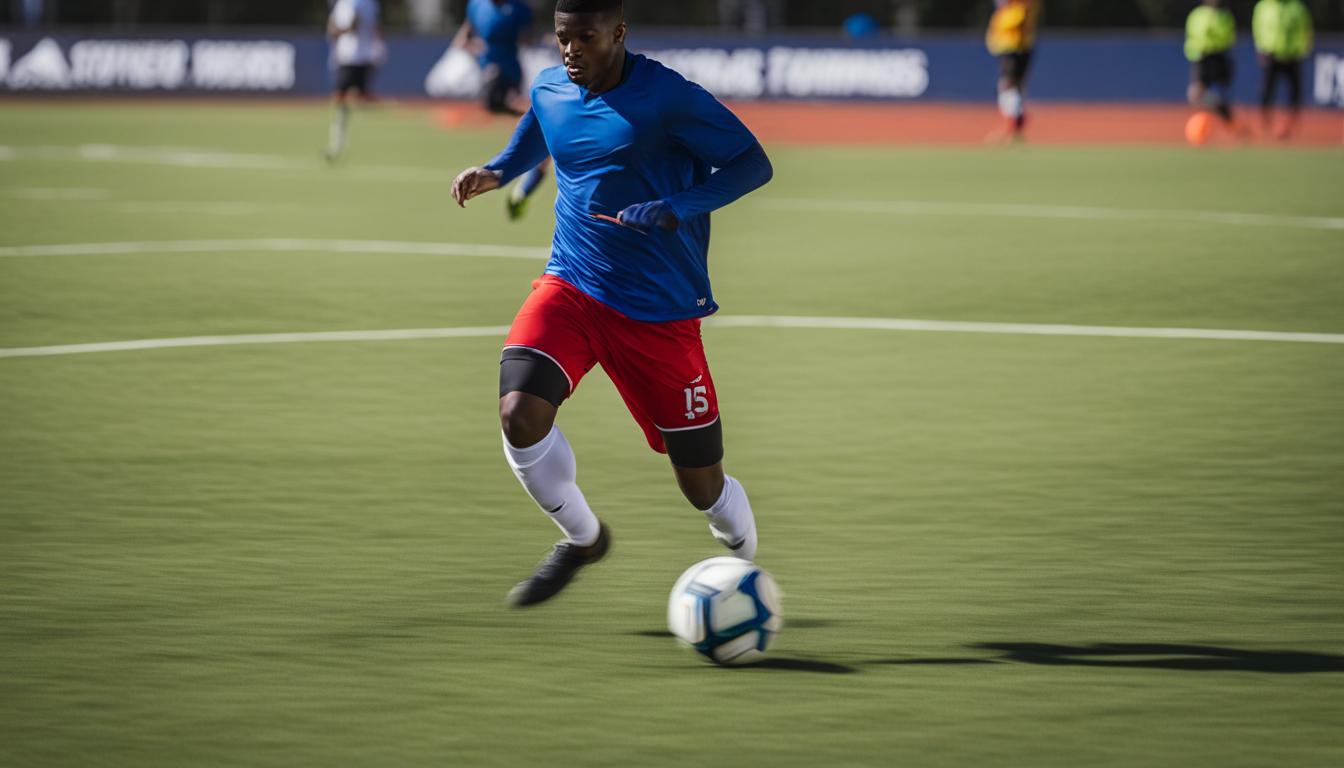Being a winger in
Key Takeaways:
- A good winger should possess speed, agility, passing ability, dribbling skills, and tactical awareness.
- Wingers play a crucial role in providing width, creating scoring opportunities, and supporting the team’s defense.
- Essential skills for a soccer winger include accurate crossing, receiving the ball in tight spaces, precise passing, and the ability to cut inside when necessary.
- Dribbling is a crucial skill for wingers as it allows them to maneuver the ball quickly and effectively.
- Wingers must contribute both offensively and defensively, balancing offensive creativity with defensive responsibilities.
What Makes a Good Winger in Soccer ?
When it comes to the winger position in football, certain qualities separate the best from the rest. Professional
Speed and Agility
A key attribute of a successful winger is their speed and agility. Wingers need to be able to sprint down the flanks, leaving defenders in their dust. Their quick acceleration and nimble footwork enable them to navigate through tight spaces and beat opponents one-on-one. The ability to change direction quickly is crucial for wingers to create scoring opportunities for their team.
Passing and Dribbling Skills
Professional
Tactical Awareness
Famous
Two-footedness
A good winger in
| Key Qualities of a Good Winger in |
|---|
| Speed and agility |
| Passing and dribbling skills |
| Tactical awareness |
| Two-footedness |
Responsibilities of a Winger in Soccer
The role of a winger in
One of the main responsibilities of a winger is to exploit space and make quick decisions on whether to pass, shoot, or dribble. Their ability to read the game and recognize opportunities to attack or provide support is crucial. Depending on the team’s formation and tactical approach, wingers may have different roles, such as inverted wings cutting inside for goal-scoring opportunities. Regardless, wingers should always be aware of their defensive duties and track back to provide cover when necessary.
Furthermore, a successful winger must possess excellent ball control, agility, and the ability to beat opponents with speed and skill. They should also have a keen understanding of positional play and the tactical aspects of the game. By combining offensive creativity with defensive contributions, wingers become valuable assets to their teams, providing width to the attack and contributing to both offensive and defensive phases of play.
Winger Responsibilities at a Glance:
- Beat opponents one-on-one using dribbling or speed
- Cross the ball into dangerous areas
- Provide defensive support in wide areas
- Recognize opportunities to pass, shoot, or dribble
- Be versatile and comfortable playing on both sides of the pitch
- Contribute creatively to the team’s attack
- Track back quickly to provide defensive cover
| Responsibility | Description |
|---|---|
| Beat opponents one-on-one | Using dribbling or speed to get past defenders. |
| Cross the ball | Delivering accurate crosses into dangerous areas to create goal-scoring opportunities. |
| Provide defensive support | Helping the team by tracking back and providing cover in wide areas. |
| Recognize opportunities | Making quick decisions on when to pass, shoot, or dribble based on the game situation. |
| Be versatile | Comfortably playing on both sides of the pitch, adapting to different formations and tactics. |
| Contribute creatively | Adding width to the team’s attack and providing goal-scoring opportunities. |
| Track back quickly | Ensuring defensive cover by quickly returning to a defensive position when needed. |
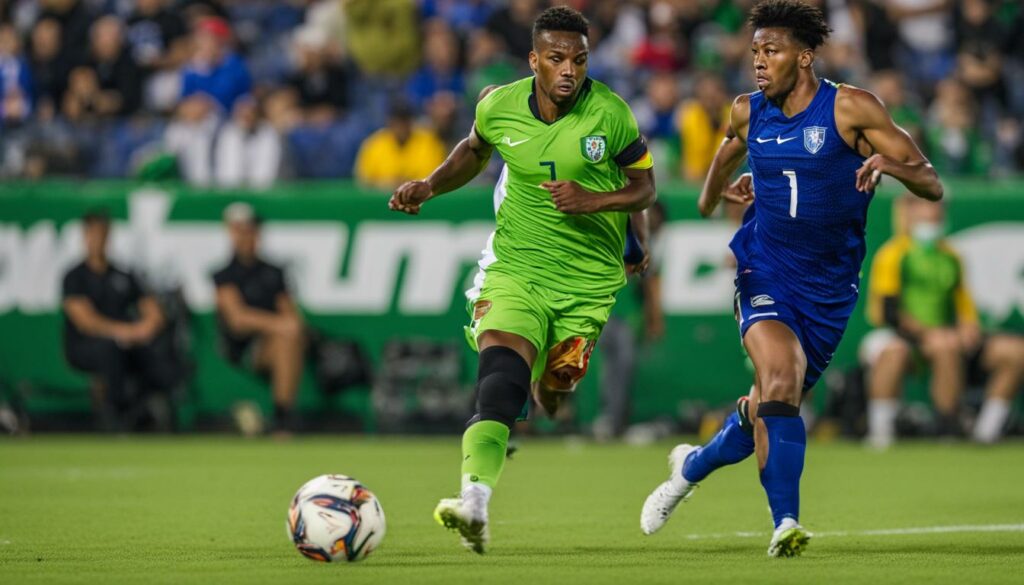
The Importance of Wingers in Soccer
Wingers play a crucial role in
Aside from their offensive contributions, wingers also play an important role in the team’s defensive efforts. They are responsible for tracking back quickly to provide cover in wide areas and help defend against counterattacks. This versatility and ability to contribute in both offense and defense make wingers highly sought after in the game.
In addition, wingers have the ability to stretch the field and create space for their teammates by occupying defenders out wide. This opens up opportunities for central players to make runs into the box or find pockets of space to receive the ball. The presence of a skilled winger can disrupt the opposing team’s defensive shape and create numerical advantages in key areas of the field.
Table: Goals Scored from Crosses and Passes in Soccer
| Season | Percentage of Goals from Crosses/Passes |
|---|---|
| 2017-2018 | 68% |
| 2018-2019 | 72% |
| 2019-2020 | 71% |
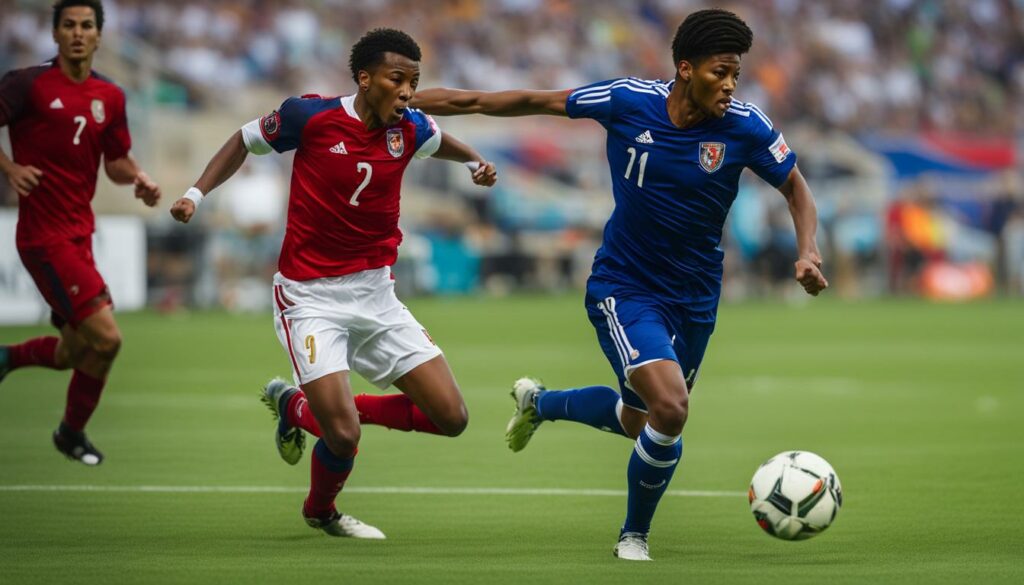
As the game of
Essential Skills for a Soccer Winger
Being a successful winger in
One of the key skills for a soccer winger is accurate crossing. Wingers must be able to deliver precise and well-timed crosses into the penalty area, creating scoring opportunities for their teammates. With the ability to read the game and understand when to cross, wingers can exploit defensive weaknesses and provide consistent service to their team.
Receiving the ball in tight spaces is another critical skill for wingers. As they often operate in wide areas where they may face tight marking, wingers need to have exceptional ball control and the ability to shield the ball from opponents. This skill enables them to maintain possession, create space for themselves, and initiate attacks for their team.
Precise passing is also essential for wingers. Wingers must be able to accurately distribute the ball both in open play and during quick combinations with teammates. Their passing ability allows them to create goal-scoring opportunities through well-weighted through balls and incisive passes into the final third.
Table: Essential Skills for a Soccer Winger
| Skills | Description |
|---|---|
| Accurate Crossing | The ability to deliver precise and well-timed crosses into the penalty area, creating scoring opportunities for teammates. |
| Receiving the Ball in Tight Spaces | The skill to control the ball and shield it from opponents in tight marking situations, enabling the creation of space for attacks. |
| Precise Passing | The ability to distribute the ball accurately, creating goal-scoring opportunities through well-weighted passes. |
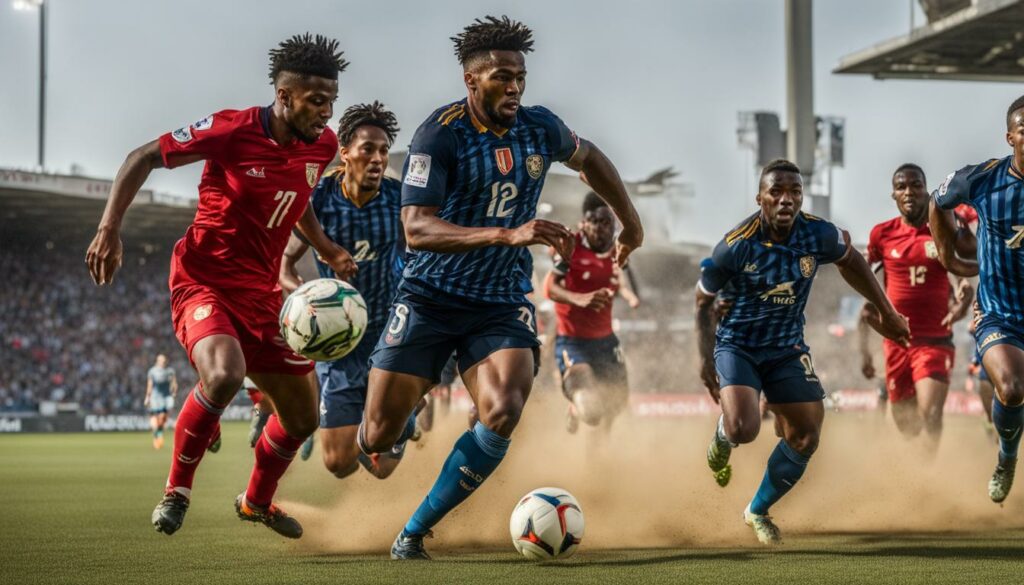
| Player | Club | National Team |
|---|---|---|
| Lionel Messi | Paris Saint-Germain | Argentina |
| Cristiano Ronaldo | Manchester United | Portugal |
| Neymar Jr. | Paris Saint-Germain | Brazil |
These players epitomize what it means to be a successful winger in
Different Forms of Wingers in Soccer
Wingers in
Classic Left Wingers
Classic left wingers are often positioned close to the touchline, stretching the play towards the opponent’s penalty area. They rely on their speed, dribbling skills, and accurate crossing ability to create goal-scoring opportunities for their teammates. These wingers excel in providing width to the team’s attack, creating space for central midfielders and strikers.
Attacking Right Wingers
Attacking right wingers are known for their ability to dribble down the flank and deliver dangerous crosses into the box. They possess excellent ball control, agility, and the vision to spot openings in the opposition’s defense. These wingers often cut inside onto their stronger foot to unleash powerful shots on goal, adding another dimension to their attacking threat.
Inverted Wingers
Inverted wingers are a modern variation of traditional wingers. These players, who primarily start on the opposite side of their stronger foot, often cut inside to create goalscoring opportunities for themselves or their teammates. By doing so, they disrupt the opposition’s defensive structure and provide a different attacking angle. Inverted wingers require exceptional technique, quick decision-making, and tactical awareness to be effective.
| Winger Type | Playing Style |
|---|---|
| Classic Left Wingers | Close to the touchline, stretching play, accurate crossing |
| Attacking Right Wingers | Dribbling down the flank, dangerous crosses, cutting inside for shots |
| Inverted Wingers | Cutting inside onto stronger foot, disrupting defense, creating goal opportunities |
These are just a few examples of the different forms of wingers in
The Importance of Dribbling for Wingers in Soccer
When it comes to playing as a winger in
Effective dribbling skills give wingers an edge on the field, enabling them to beat defenders in tight spaces and break away to deliver accurate crosses into the box. By dribbling past opponents, wingers can disrupt defensive formations, create mismatches, and provide an extra dimension to their team’s attack. Furthermore, good dribbling skills enhance a winger’s overall ball control and enable them to make precise passes and shots.
Developing strong dribbling ability requires visualization, practice, and a deep understanding of defensive pressure. Wingers must learn to read the positioning and movements of opposing defenders, identifying opportunities to exploit gaps and create chances. By honing their dribbling skills, wingers can become game-changers, capable of turning a match in their team’s favor.
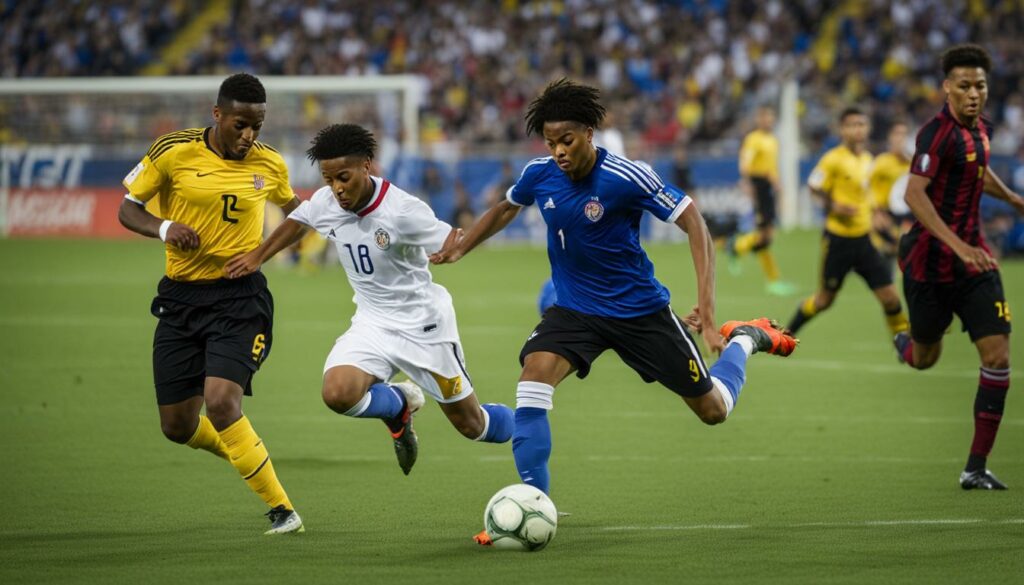
The Power of Dribbling: Key Takeaways
- Dribbling is a crucial skill for wingers in
soccer , allowing them to maneuver past defenders and create scoring opportunities. - Wingers with excellent dribbling skills can disrupt defensive formations and create mismatches on the field.
- Strong dribbling ability enhances a winger’s ball control and enables accurate passing and shooting.
- Developing dribbling skills requires visualization, practice, and an understanding of defensive pressure.
Table: Dribbling Statistics of Top Soccer Wingers
| Player | Successful Dribbles per Game | Dribble Success Rate |
|---|---|---|
| Cristiano Ronaldo | 2.8 | 64% |
| Lionel Messi | 3.5 | 72% |
| Neymar Jr | 5.1 | 80% |
| Mohamed Salah | 2.3 | 62% |
As seen in the table above, some of the top
Mastering the Art of Crossing for Wingers in Soccer
As a winger in
There are several types of crosses that wingers can utilize. Floated crosses are played high in the air, giving your teammates time to position themselves for headers or volleys. Whipped crosses are low and driven with pace, making it harder for defenders to intercept. And low crosses are along the ground, aimed at finding teammates near the goalmouth. The choice of cross depends on various factors, such as the positioning of your teammates, the movement of the defense, and the situation in the game.
Timing and decision-making are key components of successful crossing. Wingers must recognize the right moment to deliver the cross. This could involve crossing early to catch the defense off guard or waiting for teammates to create openings in the box. It’s also important to be aware of when not to cross and instead opt for a pass or take the ball into the box yourself. Developing these skills through practice and understanding the dynamics of the game will help you become a master of crossing as a winger in
The Different Types of Crosses
| Cross Type | Description |
|---|---|
| Floated Cross | A high, looping cross that gives your teammates time to position themselves for headers or volleys. |
| Whipped Cross | A low and driven cross with pace, making it harder for defenders to intercept. |
| Low Cross | A cross along the ground, aimed at finding teammates near the goalmouth. |
Mastering the art of crossing is essential for wingers in
The Complete Winger: Offensive and Defensive Contributions
Being a winger in
Offensively, wingers need to showcase their skills in soccer wing play. They should have the ability to beat defenders with their speed, agility, and dribbling skills. Precise passing and accurate crossing are essential for wingers to deliver the ball into the box and create scoring chances for their teammates. While scoring goals is not their primary responsibility, wingers who can find the back of the net add valuable contributions to the team’s attack.
Defensively, wingers must be willing to track back quickly and provide support in wide areas. They need to understand the importance of defensive contributions and be tactically aware of their positioning. Smart overlapping runs and making the right decisions in defensive situations are crucial for wingers to help the team maintain a strong defensive shape. Upholding the balance between offense and defense is what sets the best wingers apart from others.
Key Contributions of Wingers in Soccer :
- Providing width to the attack
- Creating scoring opportunities through accurate crossing and passing
- Using speed, agility, and dribbling to beat defenders
- Tracking back quickly to support the team’s defense
- Maintaining a strong defensive shape through smart positioning and decision-making
As the best wingers in
| Winger’s Offensive Contributions | Winger’s Defensive Contributions |
|---|---|
| Providing width to the attack | Tracking back quickly to support defense |
| Creating scoring opportunities through accurate crossing and passing | Maintaining a strong defensive shape through smart positioning |
| Using speed, agility, and dribbling to beat defenders | Contributing to the team’s defensive efforts in wide areas |
By mastering the offensive and defensive aspects of being a winger in
Conclusion
Mastering the role of a winger in
Dedication, practice, and a focus on technical abilities will help wingers excel in this exciting position. Whether it’s beating opponents one-on-one, delivering accurate crosses into the box, or tracking back quickly to support the defense, wingers possess the skill set necessary to impact the game.
So, if you’re passionate about being a winger in
